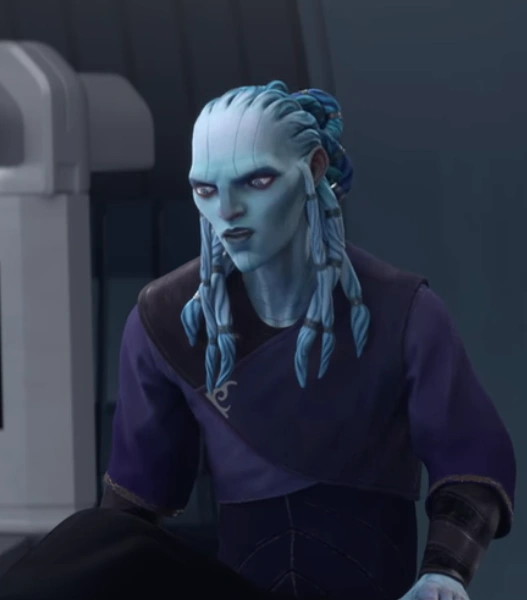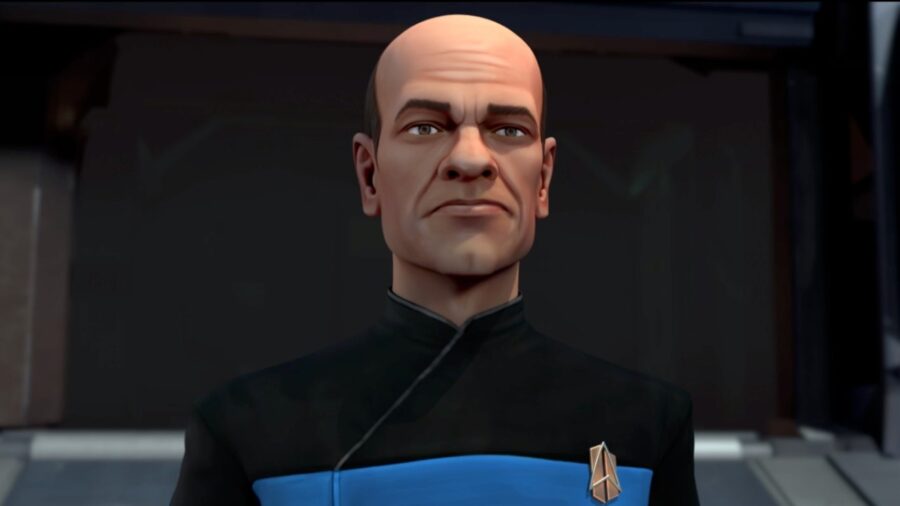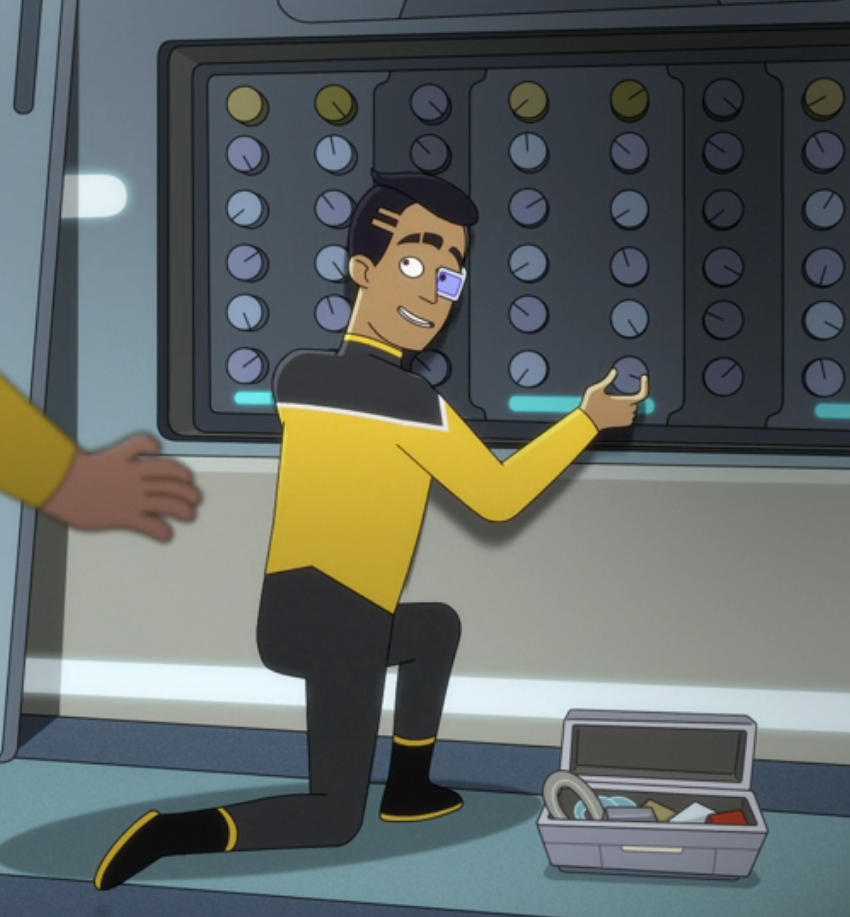The title was first used in the context of the Progenitors in TNG: “The Chase” when Picard remarked, “[The puzzle] is 4 billion years old. A computer program from a highly advanced civilisation, and it's hidden in the very fabric of life itself.“ In DIS: “Red Directive” the phrase was used in conjunction with saying the Progenitor technology was “used to design life itself.”
Burnham activates her holographic tricorder function from her tricom badge, first introduced in DIS: “Scavengers” as the 32nd Century combination tricorder, communicator and personal transporter. She also materializes a 32nd Century phaser pistol, which can be summoned at will thanks to it being composed of programmable matter.
Window-like gateways allowing instantaneous travel to other worlds was a hallmark of another ancient civilization, the Iconians (TNG: “Contagion”), who used them to control a vast empire which was destroyed over 200,000 years prior, although there were still survivors existing into the 32nd Century (DIS: “The Examples”). Their gateways also survived, with one being the focus of conflict in DS9: “To the Death”.
Tahal’s fleet will arrive in 60 minutes. Primarch Tahal is one of the five remaining Primarchs of the Bree Imperium, and in the past conquered Kellerun, Rayner’s planet. Rayner was the only survivor of his family.
Burnham has indeed seen the future - in DIS: “Face the Strange” she and Rayner were jumped 30 years ahead to see a lifeless Discovery and a Federation HQ devastated by the Breen thanks to them using Progenitor tech.
Rayner refers to the avalanche caused by Moll and L’ak on Q’Mau in order to facilitate their escape (DIS: “Red Directive”).
Culber gives Book a shot to counter radiation sickness. In TOS: “The Deadly Years”, the drug of choice to do that was hyronalin, was which also used during the TNG era in several episodes. Culber has had an existential crisis ever since he became host to the memories and personality of Jinaal on Trill (DIS: “Jinaal”).
Moll put L’ak in her personal pattern buffer in DIS: “Lagrange Point” to keep him safe.
Using plasma to take out multiple hostiles was a tactic used by Worf’s brother Kurn, who went to warp near the surface of a star, setting off a flare which destroyed his pursuers (TNG: “Redemption II”). In TNG: “Descent, Part II”, the Enterprise-D under Beverly Crusher’s command fired a particle beam into a star to make it erupt and destroy a Borg ship.
Culber tells Book to adjust the tractor beam to subspace resonance frequency 5.1732, then uses the classic “I’m a doctor, not a…” trope associated most with McCoy from TOS (my personal favorite is from TOS: “The Devil in the Dark”, where he complains about treating the silicon-based Horta with, “I’m a doctor, not a bricklayer!”).
Ferengi rummy is presumably a card game. Rummy is the name given to a group of Earth card games, with the most common variant being Gin Rummy. It is claimed that the name comes from using rum as betting stakes.
The Progenitor that greets Burnham is in an updated version of the original Progenitor makeup from TNG: “The Chase” (played then by Salome Jens, who went on to play the female Founder in DS9).
The Galactic Barrier is an energy field that surrounds the Milky Way, penetrated by the USS Enterprise in TOS: “Where No Man Has Gone Before” and then again in TOS: “By Any Other Name”. The Barrier also featured in DIS Season 4, with Species 10-C living beyond it in extragalactic space. The origins of the Barrier have never been explained on screen, although beta canon has offered some possibilities, one of which was the Progenitors (William Shatner and Judith and Garfield Reeves-Stevens’ Captain’s Glory).
The Progenitors were not the creators of the technology but think that it was made by their creators. So, basically, it’s Progenitors all the way down. And while they effectively could recreate a live body from a dead one, it would basically be a clone without any of the previous body’s memories or personality.
The Betazoid scientist Dr Marina Derex was one of those that discovered the Progenitor tech 800 years prior. Her clue was in the manuscript of her book, Labyrinths of the Mind (DIS: “Labyrinths”).
This is the first time Discovery has shown the ability to separate its saucer from its secondary hull. Saucer separation was mentioned as being possible in TOS behind the scenes documents but it was not until TNG: “Encounter at Farpoint” that separation (and rejoining) became a fact on screen.
“Infinite Diversity in Infinite Combinations” is a tenet of Vulcan philosophy, first mentioned in TOS: “Is There in Truth No Beauty?”, also known as IDIC. In-universe, it dates back to at least Surak’s time, c.300 CE (ENT: “The Forge”).
When Kovich tells her that all information regarding the Progenitor tech will be classified, Burnham quips she knows how those things work. When Discovery jumped to the 32nd Century at the end of Season 2 to prevent misuse of the Sphere Data, all knowledge of the spore drive was classified and scrubbed from 23rd century records, and even as far as the 32nd century was concerned the original Discovery was destroyed back then.
The device Burnham holds gives her access to the Infinity Room, a highly secure conference space, first seen in DIS: “Red Directive”.
Kovich cryptically says he’s “lived many years and many lives”. Given the scope of the Star Trek universe, this could very well be more than metaphorical. On the shelf behind him we see a bottle of Château Picard, Geordi LaForge’s VISOR and Benjamin Sisko’s baseball.
Agent Daniels first appeared in ENT: “Cold Front” as Crewman Daniels of the NX-01 Enterprise (which technically didn’t have a USS prefix until its refit). He was revealed to be a Time Agent, a temporal operative from the 31st Century fighting in the Temporal Cold War. He last appeared in ENT: “Storm Front, Part II”, informing Archer that due to his actions, the Temporal War was coming to an end.
Talaxians, of course, are Neelix’s race (VOY), last referenced in a reading list that included A Comprehensive Guide to Talaxian Hair Styles. The Eternal Archive also gave Book a cutting from the World Root, a tree system that extended across his now-destroyed planet Kwejian (DIS: “Labyrinths”). He planted it on Sanctuary Four, a planet used as a wildlife sanctuary for trance worms, one of which, nicknamed Molly was delivered there by Book in DIS: “That Hope is You, Part 1”.
The box on the table across from Admiral Burnham’s bed is the one made of Tulí wood, that contained the World Root cuttings, given to Book by the Eternal Archive. The color of the vegetation outside the window identifies the planet as Sanctuary Four.
Crepuscula was the very first planet we saw in the series, back in the first scene of DIS: “The Vulcan Hello”. Burnham and Philippa Georgiou performed a covert mission to restore the Crepusulans’ water supply, as the species was subject to General Order 1.
The age of Burnham’s son (and his Captain’s rank) implies that at least thirty-odd years have passed since Saru’s wedding.
Technically speaking, one “aye” means “I understand,” in response to information while “aye aye” means “I understand and will comply,” in response to an order.
Burnham’s shuttle bears the designation “UFP 47”, with 47 being a number which appears frequently in Star Trek, an in-joke started by TNG writer Joe Menosky, who was part of the 47 Society at California’s Pomona College. In the lake we see trance worms swimming. The warp streaks as the shuttle travels are consistent with what we saw of the pathway drive.
Burnham and Book’s son is named Leto, after Book’s nephew who died when Kwejian was destroyed (DIS: “Kobayashi Maru”).
The ending finally brings continuity in line with ST: “Calypso”, where Craft came across a deserted Discovery, empty save for Zora, adrift for a thousand years in deep space. For the longest time we were wondering how it would work since the starship was shown without its “A” suffix, which she obtained when refitted in the 32nd Century to hide her origins in the 23rd Century. The removal of the “A” by DOTs as Burnham’s shuttle flies in, the reattchment of the ship's nacelles and Burnham's use of the term “Red Directive” implies that this is due to Kovich/Daniels’ instructions, and the restoration of the original ship is to bring it in line with history due to timey-wimey reasons.




